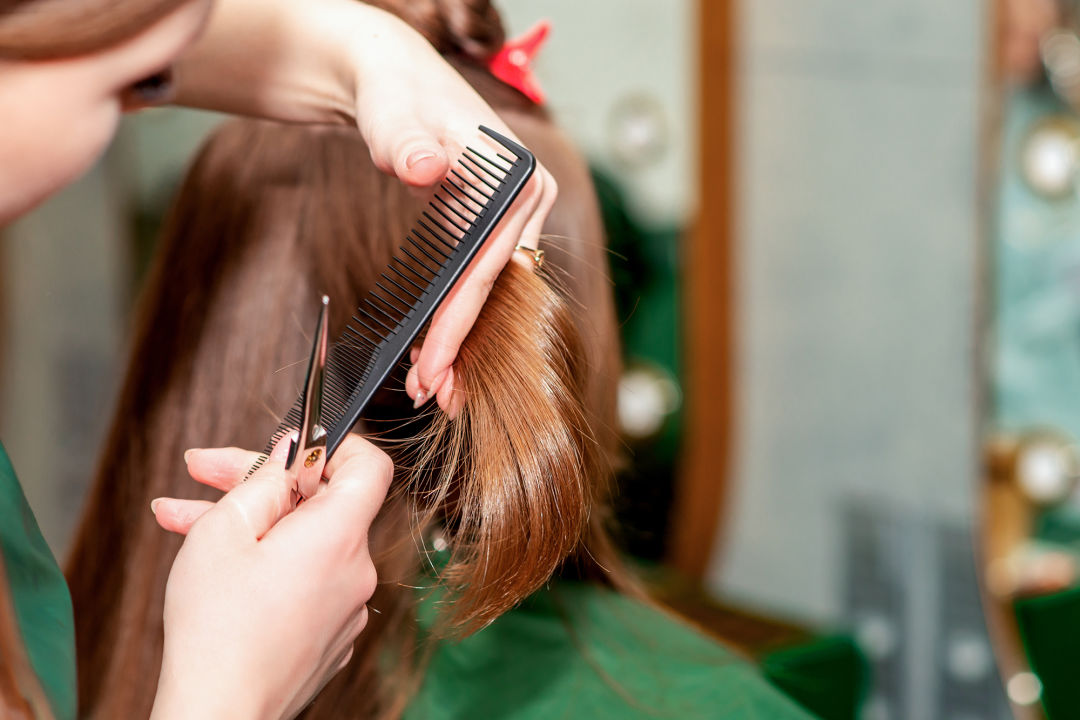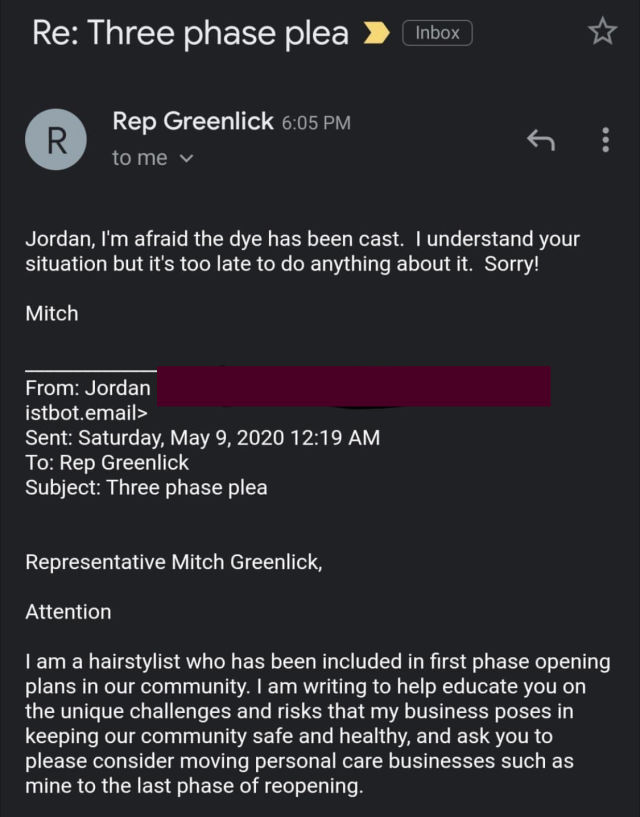Hundreds of Local Stylists Say It's Too Dangerous for Salons to Reopen

The Oregon Hairdressers Coalition currently has 200 Oregon salons all opposing Phase 1 re-entry, a Change.org petition with over 5,000 supporting signatures, and a dedicated Instagram quickly adding more names to the growing cause.
Stylists are currently listed to be up and running in Phase 1 of Gov. Kate Brown’s reopening plan, but a growing number say it puts their lives, and the community, at risk. With several salons banding together as the Oregon Hairdressers Coalition, they created a petition and social campaigns outlining the specific reasons they oppose being in Phase 1 as technicians, primarily noting the impossibility of doing their jobs in a socially distanced manner. Currently, the hair stylists, estheticians, and other hands-on practitioners have 200 Oregon salons all opposing Phase 1 re-entry, a Change.org petition with over 6,000 supporting signatures, and a dedicated Instagram quickly adding more names to the growing cause.
“I just don’t think social distancing is possible for hairstylists. When was the last time you got your hair done without someone touching you for an extended period of time?” says Nicola Corl, co-owner of Sweetheart Salon on SE Division, via email about the new guidelines that require salons to keep their clients six feet apart, but say it’s fine for stylists to be up close touching clients. “If people who work in hospitals are still contracting COVID-19 through their medical-grade PPE, why are we being asked to do the same for a service that’s important but not essential? It’s dehumanizing to be told that our clients need to be six feet apart while we are right on top of them. Are we less human? Worth less?”
The new guidelines come at a staggering cost, say salon owners. Not only do they say the guidelines call for stylists to operate at diminished capacity to maintain social distancing, but they’re also told to administer questionnaires to ask clients if they have any symptoms of COVID-19 (prompting some to wonder if they have to adhere to HIPAA guidelines) in addition to taking the temperatures of their clients and themselves, and keeping those records for 60 days. Additionally, they need to somehow procure face masks for clients, face shields, gloves, and increase sanitation, including changing clothes after each client and before going home.
None of the stylists Portland Monthly has spoken to have received unemployment insurance for the last eight weeks, though two noted they were part of the pilot program for the new Pandemic Unemployment Assistance program, hoping that would have helped speed along the process. Instead, they say they still haven’t even received any type of communication about when or if their benefits are coming, with some stylists saying they are weighing their safety against bankruptcy.
“I understand that they had to create a whole new platform, and was totally willing to be patient for that. I get that it's not something that they normally do, but I feel like the way they've gone about it is so difficult,” says Ashley Newport of the American Traditional Barbershop in Eugene who hasn’t received any unemployment or communication for the two months she’s been applying weekly. “It really is intense, and I totally see both sides. It is scary and we are all kind of in the same situation. But I couldn't with good conscience go back when I don't feel like it's safe for my community and for my clients, even if that makes it so that I'm not making money. That part I'm already used to after nine weeks.”
If salons remain in Phase 1 of the reopening plan and choose to not open after they are able—even if it is because they are financially or physically unable to acquire the necessary personal protective equipment for themselves—they would be deemed ineligible for future unemployment benefits, should those ever come through. As the group grows, with each new stylist’s specialty, a new set of safety concerns arises around PPE, and procedures arises.
“We specialize in beards and face shaves so we work very closely. There's no way that I can not be face to face with most of my clients. There’s no way to do a beard trim with a mask on,” says Newport. “The guidelines said you could temporarily remove a client's mask, which is then cross-contaminated the second it is touched, so that doesn't make any sense. And again, why would we be urged to be six feet from somebody, but we can be six inches from them doing a beard trim? That's just a blatant disregard for our safety and the clients, too.”
Confusion over the state’s guidelines is a huge part of the salon owners' concern. To receive accreditation in beauty school, technicians learn sanitation methods for their tools and how to handle blood in a safe manner as they deal with sharp objects. But nowhere in their curriculum is any instruction on airborne pathogens, they say, nor did they cover proper use of medical protective gear like the kind they are now being told to use.
“This is about our moral obligation as well. I think whenever you're providing a hands-on personal service, it's about that connection you're making with the people that you're working on,” says Ashley Weiner of downtown’s 220 Salon. “We care about our clients, and by extension, their loved ones. So the worry is definitely not just monetary—which we all feel is a huge piece of this—but also the responsibility we have to take care of those people.”
Beauty techs beyond hairstylists say this rule affects them and were particularly surprised to find they were in Phase 1 when we’ve been in lockstep with California for many of our other public safety guidelines. There, Gov. Gavin Newsom placed salons in the final phase of reopening, noting in one of his daily briefings that the state’s first case of community spread COVID-19 came from a nail salon.
“I was downright excited when it was announced that western states would be collaborating to determine best practices regarding the impact of COVID-19 and how reopening would look. So why did Governor Brown break from our Cascadian peers now? With Washington including salon practitioners in Phase 2 and California in Phase 3, it’s near impossible to not be made to feel like guinea pigs,” says waxing aesthetician Alix Zimmerman of Alix Waxes whose primary services include facial waxing, which would require clients to remove masks. “The burdens being put upon us are financially, emotionally, and in some respects legally staggering. None of us are protected under our liability insurance, and the expense of providing all clients with masks is upon the provider. Yes, I love my career. It’s my livelihood. But this is our lives on the line.”

In addition to the petitions, the coalition has been reaching out to all of its representatives trying to explain the serious potential risks of the situation. In screenshots shared with Portland Monthly, they noted some positive steps, with the most promising response from Multnomah County Chair Deborah Kafoury. “You also make really important points about the dangers and consequences of including personal care businesses in Phase 1,” she wrote. “This feedback is really important to me as I work with our public health professionals to craft a plan for reopening Multnomah County.”
A different response came from retiring District 33 Rep. Mitch Greenlick [Editor’s note: Greenlick, 85 and a member of the Oregon House since 2003, died two days after this story was published, on May 15]: “Jordan, I’m afraid the dye [sic] has been cast,” he wrote in a May 9 email. “I understand your situation but it’s too late to do anything about it. Sorry!”
Ashley Weiner says after Greenlick’s response was shared with the coalition, they read the misspelling of “die” as an intentional and poorly timed pun in reference to their profession. “That 100 percent felt like I do not care. I'm making fun of you. Deal with it,” she says. “If Governor Brown was to ask me what I needed to feel safe opening back up for business, I would say: a clear decline in cases and COVID/antibody testing for everyone; hands-on training for safety and sanitation regarding airborne pathogens; a government subsidy for the cost we will incur for PPE during this pandemic; and a clear wavier of liability if someone contracts COVID while in the salon.”




